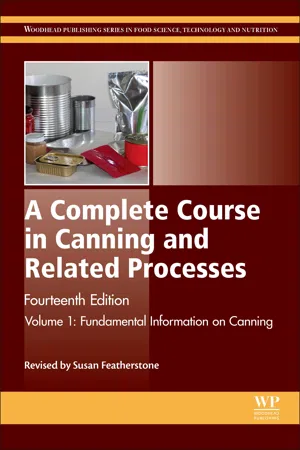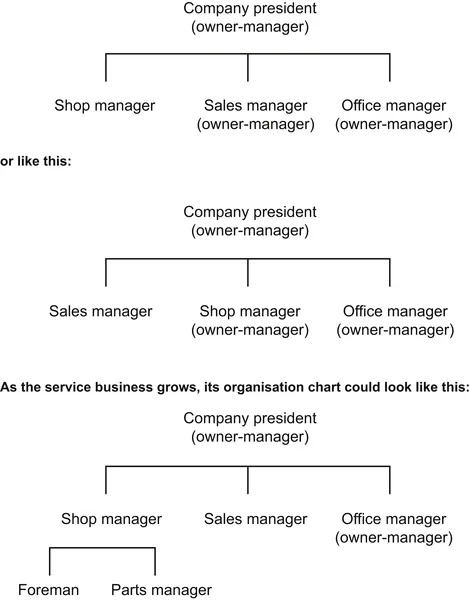
eBook - ePub
A Complete Course in Canning and Related Processes
Volume 1 Fundemental Information on Canning
- 394 pages
- English
- ePUB (mobile friendly)
- Available on iOS & Android
eBook - ePub
A Complete Course in Canning and Related Processes
Volume 1 Fundemental Information on Canning
About this book
A Complete Course in Canning and Related Processes, Fourteenth Edition: Fundamental Information on Canning provides readers with a complete course on canning.
This latest edition continues the tradition for both professionals in the canning industry and students who have benefitted from this collection for over 100 years. It contains extensively revised and expanded coverage, and the three-title set is designed to cover all phases of the canning process, including planning, processing, storage, and quality control.
Major changes for the new edition include new chapters on regulation and labeling that contrast the situation in different regions worldwide, updated information on containers for canned foods, and new information on validation and optimization of canning processes, among other topics.
- Continues the tradition of the series that has educated professionals and students for over 100 years
- Covers all aspects of the canning process, including planning, processing, storage, and control
- Analyzes worldwide food regulations, standards, and food labeling
- Incorporates processing operations, plant location, and sanitation
Frequently asked questions
Yes, you can cancel anytime from the Subscription tab in your account settings on the Perlego website. Your subscription will stay active until the end of your current billing period. Learn how to cancel your subscription.
At the moment all of our mobile-responsive ePub books are available to download via the app. Most of our PDFs are also available to download and we're working on making the final remaining ones downloadable now. Learn more here.
Perlego offers two plans: Essential and Complete
- Essential is ideal for learners and professionals who enjoy exploring a wide range of subjects. Access the Essential Library with 800,000+ trusted titles and best-sellers across business, personal growth, and the humanities. Includes unlimited reading time and Standard Read Aloud voice.
- Complete: Perfect for advanced learners and researchers needing full, unrestricted access. Unlock 1.4M+ books across hundreds of subjects, including academic and specialized titles. The Complete Plan also includes advanced features like Premium Read Aloud and Research Assistant.
We are an online textbook subscription service, where you can get access to an entire online library for less than the price of a single book per month. With over 1 million books across 1000+ topics, we’ve got you covered! Learn more here.
Look out for the read-aloud symbol on your next book to see if you can listen to it. The read-aloud tool reads text aloud for you, highlighting the text as it is being read. You can pause it, speed it up and slow it down. Learn more here.
Yes! You can use the Perlego app on both iOS or Android devices to read anytime, anywhere — even offline. Perfect for commutes or when you’re on the go.
Please note we cannot support devices running on iOS 13 and Android 7 or earlier. Learn more about using the app.
Please note we cannot support devices running on iOS 13 and Android 7 or earlier. Learn more about using the app.
Yes, you can access A Complete Course in Canning and Related Processes by Susan Featherstone in PDF and/or ePUB format, as well as other popular books in Technology & Engineering & Food Science. We have over one million books available in our catalogue for you to explore.
Information
Part One
Business planning and regulations for canned foods
1
Creating a business plan
Abstract
A business plan is a formal statement of a set of business goals and the plan for reaching those goals. It also contains background information about the organisation or team attempting to reach those goals. When an existing business undergoes a major change or when a new business is started, generally a 3–5 year business plan is required to secure the necessary funding. A business making food for public consumption will also require a clear business plan to convince local health authorities and other relevant food inspection bodies, as well as potential customers, that the products being produced will be safe and of consistently good quality.
Keywords
Assets; Business; Finance; Management; Marketing1.1. Introduction
Starting a cannery requires a substantial investment. Depending on the type of products you wish to can, you will need to get permission/licenses from the relevant food authority and will have to be inspected for hygiene compliance by the local health department. The cannery will need to comply with all of the health, fire, and safety codes in your area and may require special licensing, such as food handlers’ licenses for you and your employees. Contact your local health department to determine all of the licensing and inspection requirements for your location. Liability insurance can protect your financial position should there be a case of a contamination or a food poisoning incident, provided you can prove that all of the required measures were in place to prove due diligence.
The key to the success of any business is the comprehensive development of a written document called a business plan. A business plan describes the business, its product, market, people, operational characteristics, and financing needs. The process of putting a business plan together forces one to take an objective, critical, unemotional look at the entire business proposal. A well-prepared business plan serves several purposes:
1. For a new business, it helps the owner determine the feasibility and desirability of pursuing the steps necessary to start a business.
2. For a company seeking financing, it is an important sales document for raising capital from outside investors.
3. For a new or existing company, a business plan forms the basis of a more detailed operational plan and thus becomes an important management tool for monitoring the growth of the company and charting future directions.
4. For all companies, it is an operational tool which, when properly used, will help manage a business and work toward its success.
It has been said that many businesses fail without a business plan. No one plan will cover all situations, so it should be tailored to the specific circumstances of the proposed business, should emphasise the strengths of the venture, and address the potential problems and challenges to be faced.
1.2. Proposed outline for a business plan
The overall plan will consist of several components that will probably include the following: business organisation, a financial plan, a marketing plan, a management plan, human resource management, supply chain management, and operations management, among others. It can be helpful to view the business plan as a collection of subplans: one for each of the main business disciplines that have been identified.
1.2.1. Description of the business organisation
1.2.1.1. Business contact details
Business Name
Street Address
Mailing Address
Telephone/Fax number(s)
Website/email addresses
Owner(s) Name(s)
Business Form (proprietorship, partnership, corporation)
[If incorporated, state the jurisdictional government body such as state or country.]
Include copies of key subsidiary documents in an appendix. Partnerships require written agreements of terms and conditions to avoid later conflicts and to establish legal entities and equities. Corporations require charters, articles of incorporation, and by-laws.
1.2.1.2. Business purpose and function
In this section, write an accurate concise description of the business. Describe the business in narrative form.
1. What is the principal activity? Will this be a manufacturing or a service business?
2. How will it be started? Will it be a new start-up, the expansion of an existing business, or the purchase of a going business, and what is the actual or projected start-up date?
3. Why will it succeed? Promote your idea here.
4. What is unique about the business? What is its market ‘niche’, and how and why will this business be successful?
What is your experience in this business? Include a current resume of your career in an appendix and reference it here. If you lack specific experience, explain how you plan to gain it, such as training, apprenticeship, or working with partners who have experience.
1.2.2. Management plan
A management plan describes who will do what. Four basic sets of information need to be included:
1. State a personal history of related work and experience (including formal resumes in an Appendix).
2. List and describe specific duties and responsibilities of each individual.
3. List benefits and other forms of compensation for each individual.
4. Identify other professional resources available to the business such as: accountant, lawyer, insurance broker, banker. Describe the relationship of each to the business. For example, an accountant available on a part-time hourly basis, as needed; initial agreement calls for services not to exceed a specified number of hours per month at certain rate per hour.
To make this section graphically clear, start with a simple organisational chart that lists specific tasks and show who (type of person is more important than individual name other than for principals) will do what indicated by arrows, work flow, and lines of responsibility and/or communications. Consider the following examples:

1.2.3. Human resources plan
Human Resources (HR) is concerned with how people are managed within organisations, focusing on policies and systems. HR departments in businesses are typically responsible for a number of activities including: recruitment, training and development, performance appraisal, and rewarding (i.e. managing pay and incentive systems). HR is also concerned with industrial relations.
In the HR plan, the following questions should be answered:
• What are your personnel needs now?
• What skills must each key person have?
• Are the people needed available? Name them and indicate full or part time and salary rates.
Detail a proposed work schedule by week and month for at least the first year. Calculate total salaries, wages, fringe benefits, and payroll taxes for each month of the first year.
If any gaps in personnel skills have been identified, state with a detailed plan how these will be overcome by training, purchase of outside services, or subcontracting. Check with the nearest employment service office for assistance.
1.2.4. The marketing plan
The marketing plan is the core of a business rationale. To develop a consistent sales growth, the management must become knowledgeable about the market. To demonstrate understanding, answer several basic questions:
Who is in your market?
Describe the profile of your typical customer by age, sex, income, number in a family, location, buying patterns, and the reason to buy the product.
Geographically describe the trading area, i.e. local, regional, national, and/or international. Economically describe the trading area, i.e. single family, average earnings, number of children.
How large is the market?
What is the estimated total number of units or value of the market? Is the market growing, steady, or decreasing? If the market is growing, what is the annual growth?
Who are your competitors?
No...
Table of contents
- Cover image
- Title page
- Table of Contents
- Related titles
- Copyright
- Woodhead Publishing Series in Food Science, Technology and Nutrition
- Preface
- Introduction
- Part One. Business planning and regulations for canned foods
- Part Two. Design and upkeep of canned food factories
- Part Three. Canning operations
- Appendix
- Glossary
- Index